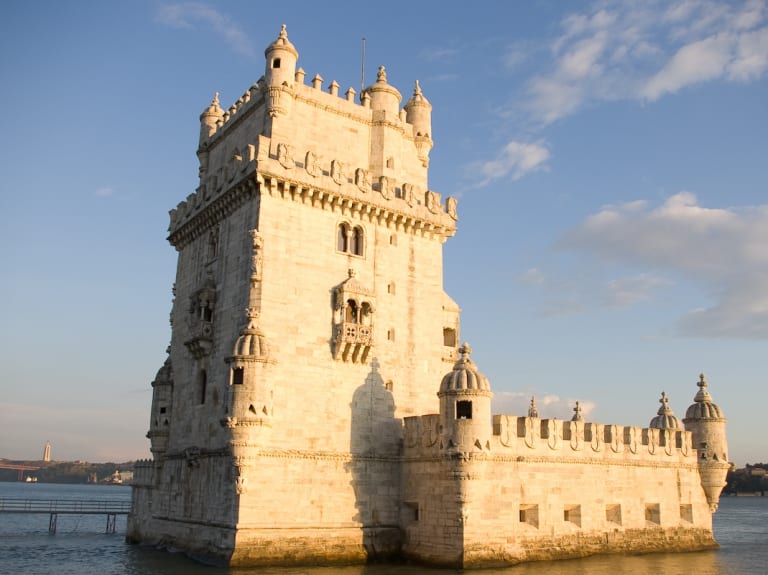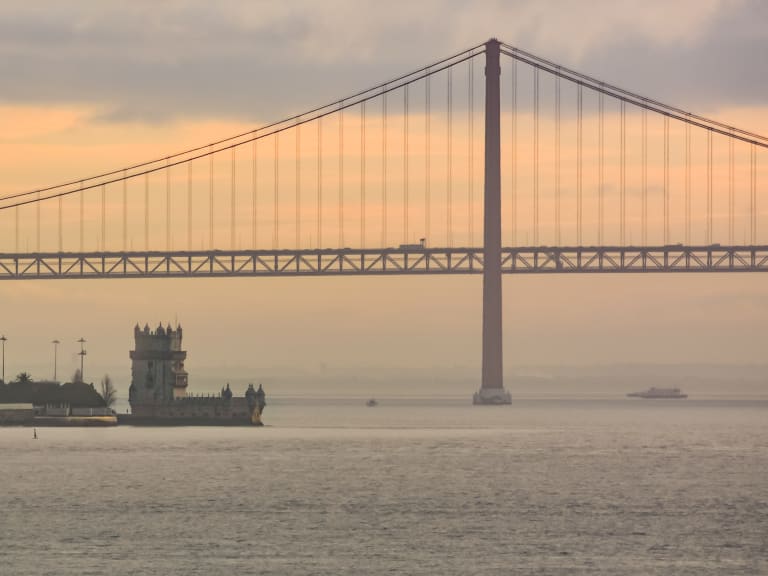More about: 10 Things to Do in Belem in Lisbon
The Belém district is located at the mouth of the Tagus River and is famous for the Jerónimos Monastery and the Belém Tower, two examples of the Manueline style. This artistic trend is very typical of Portugal and will surprise you with its extravagant decoration.
Take a guided tour

Any trip to Lisbon must necessarily pass through Belém. This area is closely linked to Portugal's colonial history; from these very shores, caravels left Europe to reach the coasts of Brazil or overseas possessions in India.
By choosing a guided tour you can discover this neighbourhood with an expert guide who will take you to see the neighbourhood's main destinations: the Jerónimos Monastery, the Padrão dos Descobrimentos and the Belém Tower. These tours usually last two hours and usually start at Praça do Império (opposite the Museu da Marina) or at the Doca de Bom Sucesso, the docks by the river. The downside of this tour is that entrance fees to museums/churches are not included.
Visit the masterpiece of Manueline architecture

The Jerónimos Monastery is a majestic religious building overlooking Praça do Império. Its history is linked to the maritime explorations and the figure of Vasco da Gama. In 1497, the Portuguese navigator set sail from the port of Santa Maria de Belém, rounded the west coast of Africa, rounded the Cape of Good Hope and reached Calicut (India) on 20 May 1498. A year later, two boats returned to Portugal laden with spices. To celebrate this new trade route, King Manuel I decided to build a large church and commissioned the architect Diogo de Boitaca to design it.
The first stop is the Church of Santa Maria de Belém, a Gothic temple with large columns and the tombs of four Portuguese monarchs, Luís de Camões and Vasco da Gama. Another environment not to be missed is the two-storey cloister in the Manueline style. Both floors are richly decorated with gargoyles, nautical symbols, medallions, tiles and much more. From October to April, it is open from 10:00 to 17:00 while from May to September it closes at 18:30.
When you find yourself in the monastery church, raise your eyes to the vault of the transept. This extraordinary dome is characterised by a spider's web-like structure but, despite its height and size, it is not supported by any columns!
Discover the symbol of the city

The Belém Tower stands in an emblematic place in Lisbon: on the old Restelo beach, from where the ships left for Brazil, Africa and the other overseas colonies. Construction began during the reign of Manuel I and was designed by Francisco de Arruda. The architect designed the bastion of Azamor, a town on the Atlantic coast of Morocco, and his stay in the Maghreb country is reflected in the decoration of the tower, which stands out for its Arabic-style elements.
The Belém Tower is open from Tuesday to Sunday from 10:00 to 17:30 (between October and April) or from 10:00 to 18:30 (between May and September).
Before entering, stop for a minute to see the rhinoceros gargoyle, a sculpture portraying the rhinoceros. The statue hides a unique history that is linked to the maritime explorations of the 16th century. In 1513, Admiral Afonso de Albuquerque returned from India with a rhinoceros and gave it as a gift to Manuel I: it was the first time this beast had set foot on European soil. At the royal court, they wondered if it was as strong as an elephant, and in order to find out, the monarch had them face each other in mortal combat. According to legend, the rhinoceros won and the king wanted to pay homage to the "strongest animal in the world".
Admire the monument that commemorates the Portuguese navigators

A few metres from the Belém Tower stands a tower reminiscent of a caravel: the Padrão dos Descobrimentos. The monument commemorates the 500th anniversary of the death of Henry the Navigator, a key figure in Portuguese history.
On the opposite side of the prow, a large cross completes the monument and at its base is a doorway. Behind this threshold is a small museum illustrating the routes of Portuguese navigators. From here you can go up to the viewpoint that offers splendid views over the sports bridge, the Tagus River, the 25th of April Bridge and the Jerónimos Monastery. If you like scenic spots, you have chosen the right city. Lisbon is also famous for its belvederes and the most prized are in the nearby Alfama district.
From October to February, the Padrão dos Descobrimentos is closed on Mondays, while on other days it is open from 10:00 to 18:00. From March to September, it is open daily from 10:00 to 19:00.
Admire the city from the Tagus

To see the tower, the Jerónimos Monastery and the Padrão dos Descobrimentos from a different perspective, you can opt for a river cruise on the Tagus. Excursions depart from the port of Belém or other central Lisbon districts. A good option could be a boat trip at sunset. This way, you can see the main monuments of the Portuguese capital as you cruise along the river.
Boats usually reach Praça do Comércio passing under one of the city's icons: the 25th of April Bridge, the longest suspension bridge in Europe. Inaugurated in 1966 as the Salazar Bridge, it changed its name after the Carnation Revolution of 1974. Its shape and red colour make it similar to the Golden Gate Bridge in San Francisco.
If you are travelling to Lisbon in summer, I recommend booking tours in advance. In the warmer months, these tours are very busy.
Relive the past at the Carriage Museum

Until the 19th century, Lisbon's long avenues and steep slopes were traversed by a multitude of carriages. Royalty moved about in lavishly decorated carriages and many of these have left the streets to be housed in the Museu Nacional dos Coches.
The museum is divided into two parts: some vehicles rest in the Picadeiro Real (the former equestrian arena of Lusitanian royalty), others in a modern structure designed by Brazilian architect Paulo Mendes da Rocha. Both buildings are located in Praça Afonso de Albuquerque.
If you are arriving from the centre of Lisbon, you can take tram 15 to the Belém stop. The journey takes about 20 minutes. If you are a transport enthusiast, I recommend a visit to the Museu da Carris, a cultural institution that houses double-decker buses, metro cars, horse-drawn carriages, trams and much more. From Praça Afonso de Albuquerque take tram 15 (this time in the opposite direction) and get off at the Estação De Santo Amaro stop.
Make a stop at Casa Pastéis de Belém.

In Lisbon, pastéis de Belém are an institution and the pastry shop that uses the original recipe from the 19th century is located in this area of the city. Naturally we're talking about Casa Pastéis de Belém, the establishment at Rua de Belém 84. You'll recognise it by the tiles on its façade and the queue that often forms at the entrance. The pancakes that come out of this place every day are a delight for the palate and are worth the wait. In addition to the pastries, you can also buy a Bolo Inglês, sweet and savoury assortments and jams.
During the Christmas season the offer is complemented by bolo-rey and bolo-rainha, two Portuguese versions of the roscón de reyes. If you are travelling at this time of year, I recommend you read the post 10 things to see and do in Lisbon in December.
Dive into modern and contemporary art

A short distance from the Jerónimos Monastery is the Coleção Berardo Museum, now converted into the Museu de Arte Contemporanea, a cultural institution that brings together more than 900 works of the main artistic currents of the 19th and 20th centuries.
Among the most relevant creations, we must mention Picasso's "Femme dans un fauteuil" and "Tête de femme", Andy Warhol's "Brillo Box" (wooden cubes recreating sponge containers) and Francis Bacon's "Oedipus and the Sphinx according to Ingres". The museum has won a Tripadvisor Traveller's choice in 2021 and is definitely worth a visit. It is located in Praça do Império and general admission costs approximately €5.
Mateo's tip
If you like contemporary art and you visit the Portuguese capital at the weekend, you're in luck - admission is free on Saturdays!
Come and see the newcomer in the neighbourhood: MAAT.

The riverside is home to a cultural institution of great interest: the MAAT, the Museum of Art, Architecture and Technology of Lisbon. It is located next to the city's old power station and its shape simulates a wave on the Tagus. Opened in October 2016, it hosts exhibitions of contemporary artists, architects and thinkers. It is also used for some concerts and film screenings.
Architecturally, this building is characterised by 15,000 three-dimensional tiles reflecting the reflections of the water and by its public vantage point overlooking the other bank of the Tagus. The two buildings that compose it (Central - Electricity Museum and MAAT) are open from 11:00 to 19:00, from Wednesday to Monday.
To complete your visit, you can have a drink at maat Café & Kitchen, a restaurant that offers Mediterranean-style signature cuisine. Its speciality is fish and seafood from the Portuguese coast.
Walk through the door of an iconic stadium

Football fan? Then you'll be pleased to know that the Belém neighbourhood is home to the stadium of Os Belenenses, Lisbon's third largest team and the fourth largest national team in terms of number of fans. The Estadio do Restelo has been their home since 23 September 1956, when the locals won 2-1 against the more powerful Sporting. The stadium has a capacity of 19,856 spectators and has a beautiful view over the Jerónimos Monastery and the river. If you feel like it, you can visit it with a guided tour. If you are interested, I recommend you check its official website.




